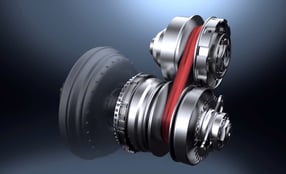CVT Technologies: What's Inside?
 One of the hottest topics in the transmission sphere is the debate over how many gears today's applications need. Is the traditional three, four, or six speed enough? What about these new units with as many as eight to ten gears? Are they really that much better? As the trends move toward more gears in traditional step applications, a different piece of technology is shaking things up: the continuously variable transmission (CVT) that virtually eliminates the need for a set number of gears.
One of the hottest topics in the transmission sphere is the debate over how many gears today's applications need. Is the traditional three, four, or six speed enough? What about these new units with as many as eight to ten gears? Are they really that much better? As the trends move toward more gears in traditional step applications, a different piece of technology is shaking things up: the continuously variable transmission (CVT) that virtually eliminates the need for a set number of gears.
In this post, we'll discuss why CVT transmissions are causing a stir in the transmission world, as well as the technology you'll find inside that produces an unlimited number of gear ratios on the road.
What is a CVT?
The idea behind CVT design is the elimination of physical steps between high and low speeds. This design allows the transmission to optimize engine speed in a variety of conditions, creating an infinite number of gear ratios that would traditionally fall "between" gears in a step unit. The CVT doesn't have to choose the correct gear according to driver input; it adjusts to create the custom gear ratio for smooth acceleration and efficient fuel mileage. Low production costs are certainly an additional benefit of CVTs for both drivers and manufacturers.
While CVTs have been in development for several years, initial applications that were met with criticism have been replaced by more advanced and reliable units. While some drivers notice a decrease in power, an odd sensation in the smooth gear transition, and are maybe even skeptical of the physical components in CVTs, manufacturers are moving forward with the innovation. CVTs today are offered on a wide range of major manufacturer models, some even coming standard.
Technology Within CVTs
 While there are variations of CVT technology on the market, general pulley-based CVTs are made up a relatively straight-forward combination of three parts:
While there are variations of CVT technology on the market, general pulley-based CVTs are made up a relatively straight-forward combination of three parts:
- The variable input pulley
- The variable output pulley
- A steel or chain belt
Each pulley is made of two 20-degree cones pointed inward at each other. The steel or chain belt runs between the two pulleys. The input and output pulleys have a variable diameter, meaning that the cones can adjust and move closer and farther to one another based on input. As the gap between the two cones is decreased, the cone forces the belt to ride on the outside diameter of the pulley to create a higher "gear". The diameter decreases when the gap between the cones is larger, letting the belt ride at the inner diameter.
At the other end of the belt, the output pulley is being turned and doing the opposite of the input pulley is doing when changing a ratio. This is to say as one pulley is opening the other pulley is closing, effectively changing the ratio by changing where the belt rides on the pulleys. Power is eventually transferred from the output pulley to the drive wheels on the vehicle. The change in belt diameter at the pulleys is what creates the possibility of infinite gear ratios.
The introduction of strong yet flexible metal belts that are more reliable and decrease the "rubber band" feeling reported by earlier CVT drivers. These metal belts can endure much more engine torque and resist slipping.
The Future of CVT Technology
While CVT technology provides an array of benefits, some drivers have difficulty getting past the initial change in drive-feel. Drivers of CVTs are inherently less involved in the shifting process, and for some, that's more of a plus than a minus. However, as manufacturers continue to develop CVT technology even further and push for more CVT-driven models, the transmission industry might be seeing a lot more CVT in its future. You might even think of CVT as the new version of "smart" shifting, given its ability to adjust to changes in input and conditions and customization qualities. But especially when it comes to major manufacturers of daily driver vehicles, it's worth keeping your eyes open for an increase of CVTs in your rebuild shop someday soon.


